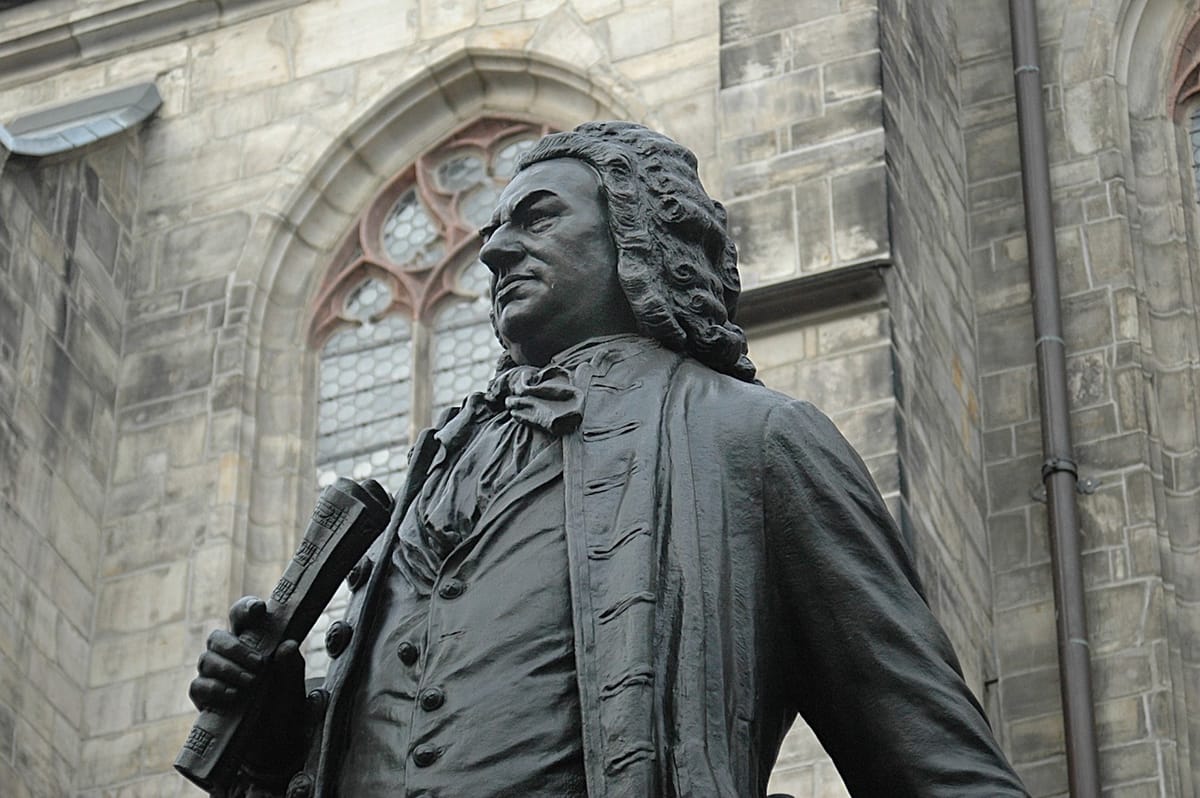300 years of Bach’s St. John Passion

I set aside some time this Good Friday to listen to the complete St. John Passion by Johann Sebastian Bach (1685-1750).
Besides being fitting music for that day of the Holy Week, this year marks the 300th anniversary of the work.
In Christian music, a Passion is a setting of the Passion of Christ (i.e. the short final period before the death of Jesus, described in the four canonical gospels and commemorated in Christianity every year during Holy Week). The word Passion itself comes from the Latin ‘patior’, “to suffer, bear, endure”. We have a similar-sounding word in Konkani, from this same origin.
From 1723, Bach was employed as Thomaskantor (cantor at St Thomas’s) in Leipzig. The job description included, among other things, composing music for the principal Lutheran churches of the city.
According to his “Nekrolog”, the 1754 obituary written by Johann Friedrich Agricola and the composer’s son Carl Philipp Emanuel, Bach wrote “five Passions, of which one is for double chorus”. The “double chorus” one is easily identified as the better-known St. Matthew Passion. Of the others, the St. John Passion is the only extant one that we know for certain was composed by Bach. The St. Luke Passion which was formerly attributed to him and even included in the BWV (Bach-Werke-Verzeichnis, Bach Works directory) under the number 246, now appears under the heading ‘apocryphal’ or ‘anonymous.’
There are as many as five versions of this Passion. The work is most often heard today in the 1739–1749 version (never performed during Bach’s lifetime). In 1749, Bach performed the St John Passion once more, in an expanded and altered form from the 1724 version, in what would be his last performance of a Passion.
German musicologist Christoph Wolff writes: “Bach experimented with the St John Passion as he did with no other large-scale composition. The work accompanied Bach right from his first year as Kantor of St Thomas’s to the penultimate year of his life and thus, for that reason alone, how close it must have been to his heart.”
I won’t get into comparisons between his two known Passions, apart from stating the obvious, that the St. John Passion as about an hour shorter, and the orchestration simpler than the later (1727) St. Matthew Passion. St. John Passion doesn’t get performed or recorded as much, and is therefore less well-known.
I found it helpful to listen with the score (you can get YouTube versions where the score scrolls in real-time with the music). I am able to follow the German text, but there are easily-accessible English translations online.
Bach uses chapters 18 and 19 of the Gospel of St, John from the Lutheran Bible, with the Evangelist using the exact same words. The Passio is divided into two Parts. Part One has two scenes, one in the Kidron valley (which separates the Temple mount from the Mount of Olives), the second in the palace of high priest Caiaphas. Part Two has three scenes: one with Pontius Pilate, one at Golgotha and finally the burial site.
This is essentially an enaction, so there are ‘dramatis personae’. The narrator is the Evangelist (John here), a tenor. Jesus and all other male characters are sung by a bass (including Peter and Pilate) or tenor (servant); female characters (such as the Maid) are sung by a soprano, while the people who are often summarily called die Jüden (the Jews), the servants of the High Priest, and the soldiers are sung by a four-part chorus (SATB) in dramatic ‘turba’ or ‘crowd’ movements.
We get drama in spades in this Passion. From the very beginning we are cast right into the action: “Betrayal and Arrest” (the Garden of Gethsemane). The music is almost cinematic, the chromatic undulations in the violins, the viola line sometimes rocking like an anxious heartbeat (or is it hyperventilation?). There is discord and dissonance, resolved for a second, only to get ratcheted up a notch higher, an upward spiral of tension, release, even more tension; until the chorus bursts onto the scene. “Herr! Herr Unser Herrschen!” (“Lord! Lord! Our Master!”). The exclamations “Herr!” are sometimes on the strong beats, sometimes on the weak, adding to the sense of unrest.
The contrasts are striking; for example, the calm measured pace of the recitative setting the ground for Judas’ betrayal, and then Jesus’ query “Who do you seek?” is answered frenetically by the ‘turba’ chorus “Jesus of Nazareth!”
The dramatic narrative is interrupted periodically by eleven chorales that allow the faithful, the congregation to participate in the Passion. Their text and even sometimes melodies would have been known to contemporary congregations but so masterful are their four-part harmonisations by Bach that they are held up to this day as templates for basic principles of composition. Many Lutheran chorales are still used in worship in German-speaking countries even today.
The ten arias are an opportunity for us to reflect on significant points in the narrative.
There are so many remarkable moments in this work, but the one that stands out is Peter’s denial. Soon after the Evangelist recites ‘And Simon Peter followed Jesus’, there is a beautiful upbeat soprano aria ‘I follow you with eager steps.’ But this is immediately followed by Peter’s first denial.
The way the St John Gospel plays out, it is a while (the striking of Jesus followed by a beautiful chorale ‘Who has hit you like that, my Saviour, and ill-treated you?’) before the Peter is accused twice more. The second accusation by the chorus is particularly vicious, attacking Peter without respite. After the crowing of the rooster, the Evangelist sings plangently “he went away and cried bitterly”, almost sobbing the melodic line, commiserating with Peter. The following aria reflects Peter’s ‘troubled mind’? It is something we can all relate to. If we were in Peter’s position, what would we have done?
Two more notable moments in Part Two: the bass aria ‘Mein teurer Heiland’ (‘My dear Saviour’) and the final chorus ‘Ruht wohl, ihr helige Gebeine’ (Lie in peace, sacred body).
Bach was himself a deeply devout individual. Barely a year into his new post in Leipzig, this was his opportunity to show on a large scale what his music could do in defining and strengthening Christian belief. As English conductor and Bach expert Sir John Eliot Gardiner writes in his scholarly 2013 book ‘Bach: Music in the Castle of Heaven’ about the first performance of the St. John Passion on Good Friday 7 April 1724: “None could match the depth of [Bach’s] elaborately patterned music- his meshing of narrative and reflection of scriptural chronicles and theologically shaped poetic texts. In a university city famed for its theological faculty, it was a courageous – some might even have called it a brazen – statement, coming as it did from someone who was not a theologian and who did not even have a university degree.”
But such are the ways of the Lord. The works of the ‘non-theologian’, non-degree holder Johann Sebastian Bach have been the subject of study by theologians and university dons and academicians the world over for the centuries that have followed his death, and will continue to be so for centuries to come.
This article first appeared in The Navhind Times, Goa, India.





